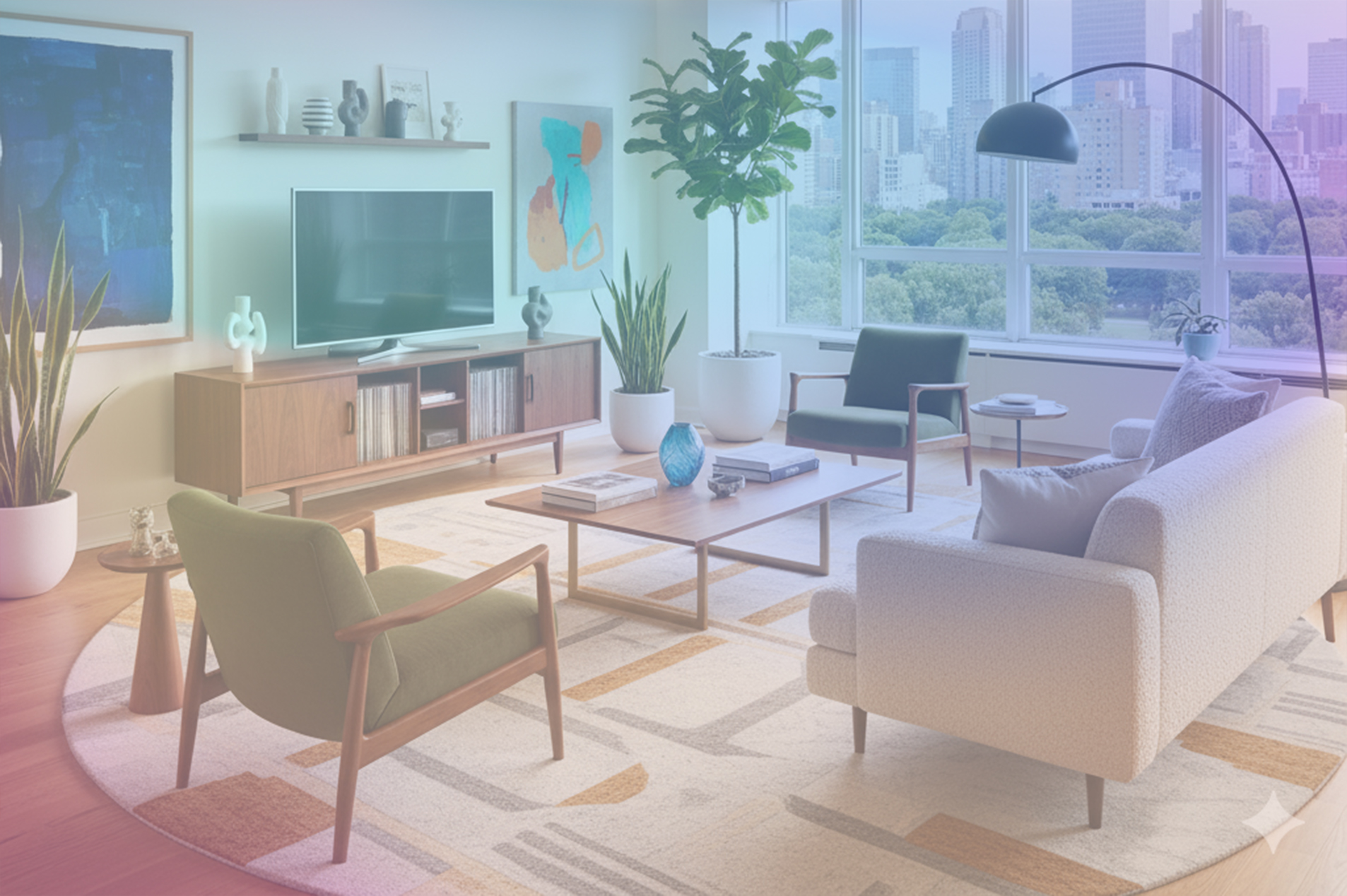This article is a practical guide for furniture brands that want to use AI responsibly and strategically — not as a gimmick, but as a business multiplier that speeds creative ideation, tightens production workflows, and makes personalization meaningful for high-ticket, high-consideration sales.
Why AI matters for furniture marketing right now
Three blunt facts explain why AI matters for brands that sell sofas, seating, and high-end contract pieces:
- Creative volume demands are rising. Showrooms, trade programs, social feeds, product pages, and specification assets all need frequent refreshes. AI helps produce many more iterations with the same creative budget.
- Buyers expect visual fidelity and configurability. Designers want BIM and CAD, consumers want to visualize furniture in their space, and both segments expect high-res images and quick mockups. AI accelerates mockups, visualization, and personalization.
- Long sales cycles reward sustained relevance. For purchases that take months, personalized touchpoints (tailored emails, dynamic ads, design-specific content) move the needle. AI makes ongoing personalization at scale achievable.
Put simply: AI lowers the cost of experimentation and increases the speed of iteration — two things that matter when you’re balancing high-touch selling with a need to appear everywhere.
Creative ideation: faster, broader, more on-brand
AI shines first as an ideation engine. But ideation alone is worthless unless it’s aligned with brand, material reality, and production constraints.
How to use AI for ideation the smart way:
- Rapid moodboarding. Seed AI with a few brand images, project photos, and material swatches to generate multiple high-level concepts for seasonal campaigns, showrooms, or editorial shoots. Use those as starting points for art direction.
- Concept-to-brief workflows. Ask AI to take a short prompt — e.g., “warm, Scandinavian-inspired lounge for boutique hotel lobby” — and produce a one-page creative brief with color palette, product focal points, sample shot list, and suggested copy hooks. Hand that to your photographer or designer to save scoping time.
- Copy scaffolding and tone variants. Generate headline pack concepts, microcopy for product tiles, and multi-length captions for social channels. Then A/B test the top performers.
- Design-system-aware prompts. Maintain a short brand style guide (voice, dos/don’ts, palette) and feed it into the AI so ideation outputs stay on-brand.
A key discipline: treat AI output as first draft. Always layer brand review and human refinement on top to preserve quality and distinctiveness.
Production & creative ops: scale without losing control
The job of scaling creative is largely operational. AI can automate repetitive tasks and create many content permutations, but you must build guardrails.
Tactical moves:
- Template-driven generation. Create a small set of brand templates (layouts for product pages, carousel posts, showroom hero images). Use AI to populate these templates with different products, finishes, and copy variants. This generates many assets from one brief.
- Batch visual variants for testing. Produce multiple versions of an image (lighting, vignette, color treatment) to test which aesthetic drives higher engagement among different audiences.
- Asset metadata at creation. When AI generates an image or caption, attach structured metadata immediately (product IDs, finish options, suggested tags). This makes downstream tagging, search, and personalization far easier.
- Human-in-the-loop QC. Build a quick review step: a designer checks AI images for realism, a merchandiser validates product specs in copy, and a legal/content lead checks claims. This mitigates hallucinations and factual errors.
Operational payoff: faster turnaround, more creative options in each campaign, and a cleaner handoff between marketing, sales, and product teams.
Personalization across long sales cycles
Personalization is more than swapping a hero image — it’s creating relevance throughout a customer’s months-long journey.
Practical personalization patterns for furniture:
- Micro-personalized nurture. Tie micro-conversions (sample requests, saved product lists, showroom visits) to personalized sequences: product follow-ups with matching moodboards, comparison tables, and occasionally, financing or lead-time nudges.
- Dynamic product recommendations for specifiers. For trade users who request BIM files or samples, present “complementary” product bundles (e.g., seating + tables + upholstery options) that reflect project scale and typical FF&E lineups.
- Personalized homepage / showroom landing. If a known trade lead returns, show projects, case studies, or SKUs aligned to their last activity — e.g., hospitality-focused content for someone looking at booth seating.
- Experiment with content cadence. For long sales cycles, changing the frequency and format of outreach (visual re-engagement vs. technical spec reminders) improves conversion without fatiguing the lead.
AI enables these patterns by predicting which micro-signal correlates with conversion and automating tailored messages at scale — but remember to preserve human service when the lead becomes high-value.
Commerce and sales enablement: smarter tools for high-ticket selling
AI can tighten the loop between inspiration and purchase in ways that suit the furniture category.
Use cases that matter:
- Virtual styling and AR previews. Allow consumers and specifiers to visualize an item in context. AI can speed photoreal mockups and suggest scale, placement, and complementary items.
- Instant quoting and configurators. Combine configurators with AI-assisted suggestions (e.g., “For this room and budget, these upholstery choices age best”) that reduce decision time.
- Intelligent chat & triage. Use an AI assistant to qualify leads, schedule showroom appointments, capture project specs, and route hot leads to a rep. Keep a smooth handoff to human sellers for complex deals.
- Spec-ready automation. Auto-generate BOMs, spec sheets, or RFQ responses from product data and a short designer brief — saving hours for both specifier and rep.
The aim is to remove friction — not replace human expertise. AI should reduce busywork and surface the high-value conversations.
Measurement, experiments & guardrails
AI opens new levers; measurement proves which ones matter.
What to measure:
- Creative lift tests. Run controlled tests to see whether AI-generated imagery or copy increases qualified leads, sample requests, or showroom bookings.
- Lead quality vs. quantity. Track downstream conversion of AI-driven leads versus traditional outreach to make sure scale isn’t diluting quality.
- Personalization efficacy. Measure lift in conversion rates and time-to-order for cohorts receiving AI-personalized journeys.
- Operational KPIs. Time saved per asset, cost per creative variant, and review cycle time — these prove internal ROI.
Experimentation note: With longer sales cycles, use cohort windows (30/90/180+ days) to understand true impact. And always run holdout tests where feasible to measure causality.
Risks & ethical guardrails
Don’t let the allure of scale come at the cost of brand integrity.
Key guardrails:
- Avoid hallucinations. AI can invent specs, lead times, and certifications. Verify any product facts before publishing.
- Protect craft and distinctiveness. Over-relying on generic prompts produces homogenized creative. Keep a human creative director shaping AI outputs.
- Data privacy & consent. When personalization uses client data, ensure opt-ins are clear and data handling meets regulations and brand promises.
- Quality over quantity. Rapid generation can overwhelm channels; curate outputs to maintain the elevated brand voice furniture buyers expect.
A practical 90-day roadmap to get started
- Pilot ideation: Run two creative sprints using AI to generate 50 hero-image variations + 30 caption variants. Pick winners and human-refine into a campaign.
- Set up human-in-loop QC: Define a 3-person review for all AI content (creative lead, merchandiser, legal).
- Integrate with creative ops: Add metadata tagging to every AI-generated asset so your DAM and commerce system can use them.
- Personalization pilot: Use AI to power a single personalized nurture journey for sample-request leads. Measure sample→showroom→order over 90 days.
- Scale what works: Move winning creative templates into templated generation and scale personalization to larger cohorts.
Conclusion: use AI to amplify, not replace
AI’s value for furniture marketing is pragmatic: it speeds ideation, multiplies tested creative, and makes long-cycle personalization achievable. But the rules of this category still apply: authenticity, craftsmanship, and trust are everything. Use AI to remove friction, free creative time, and create better conversations between brand and buyer — and always keep a human in charge of the decisions that matter.





